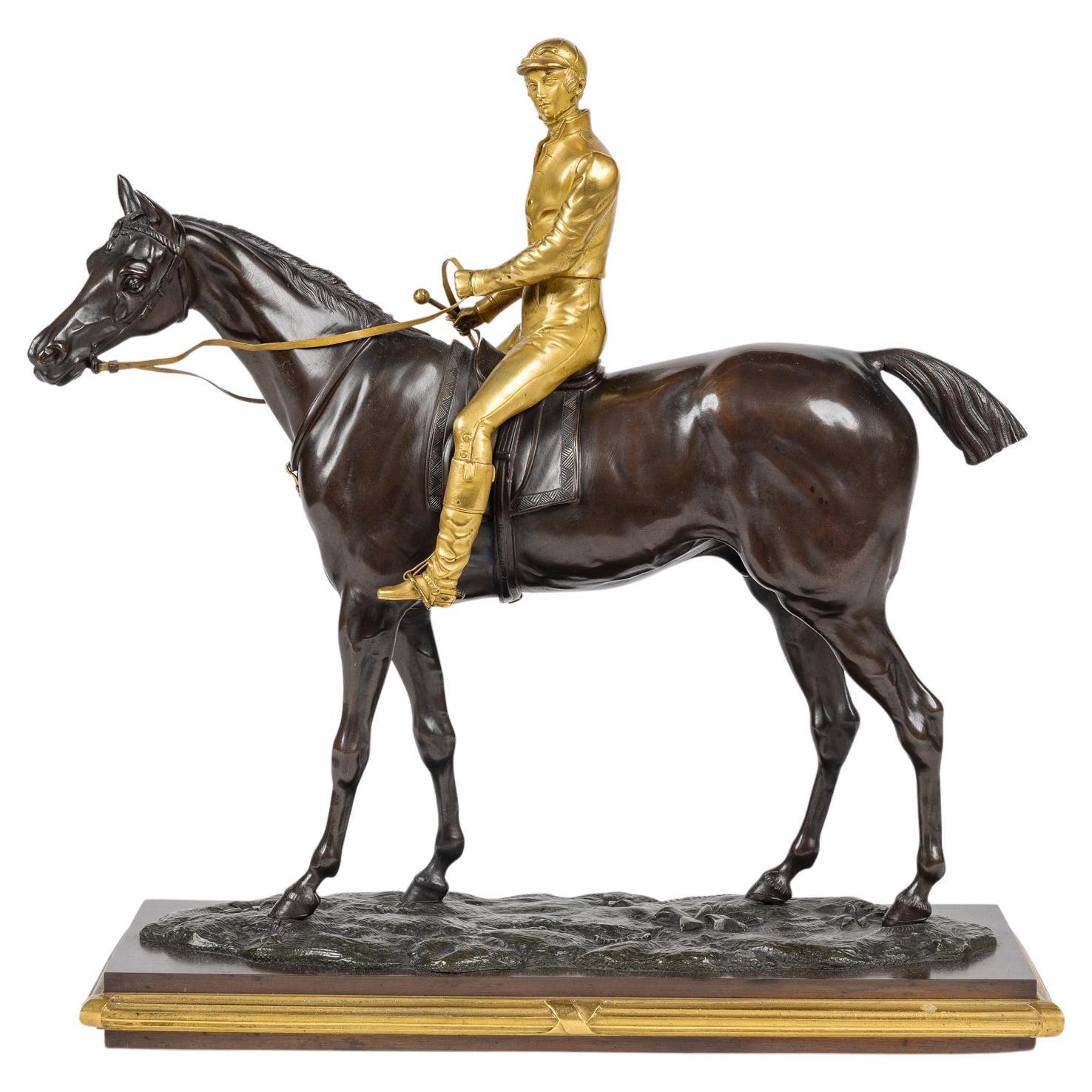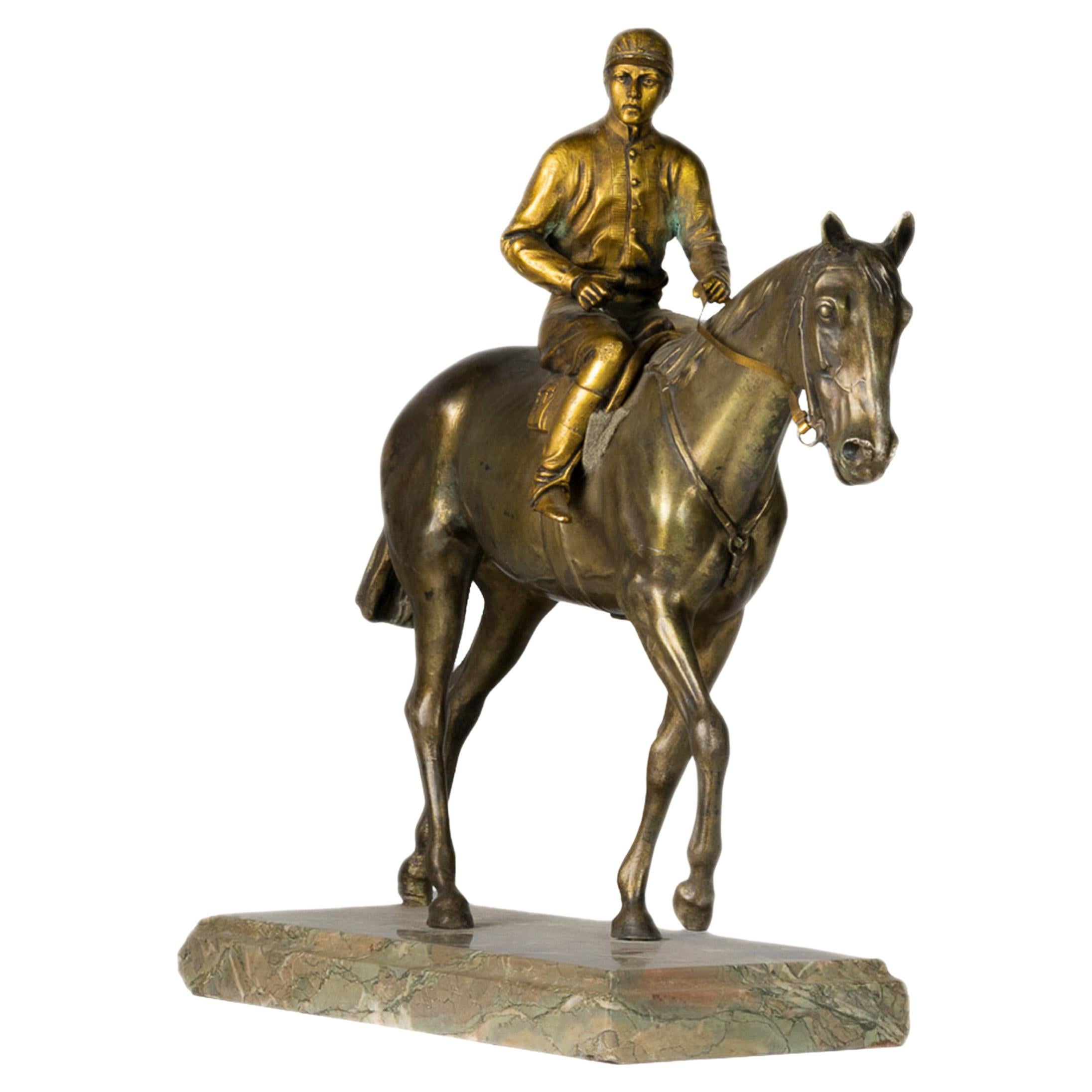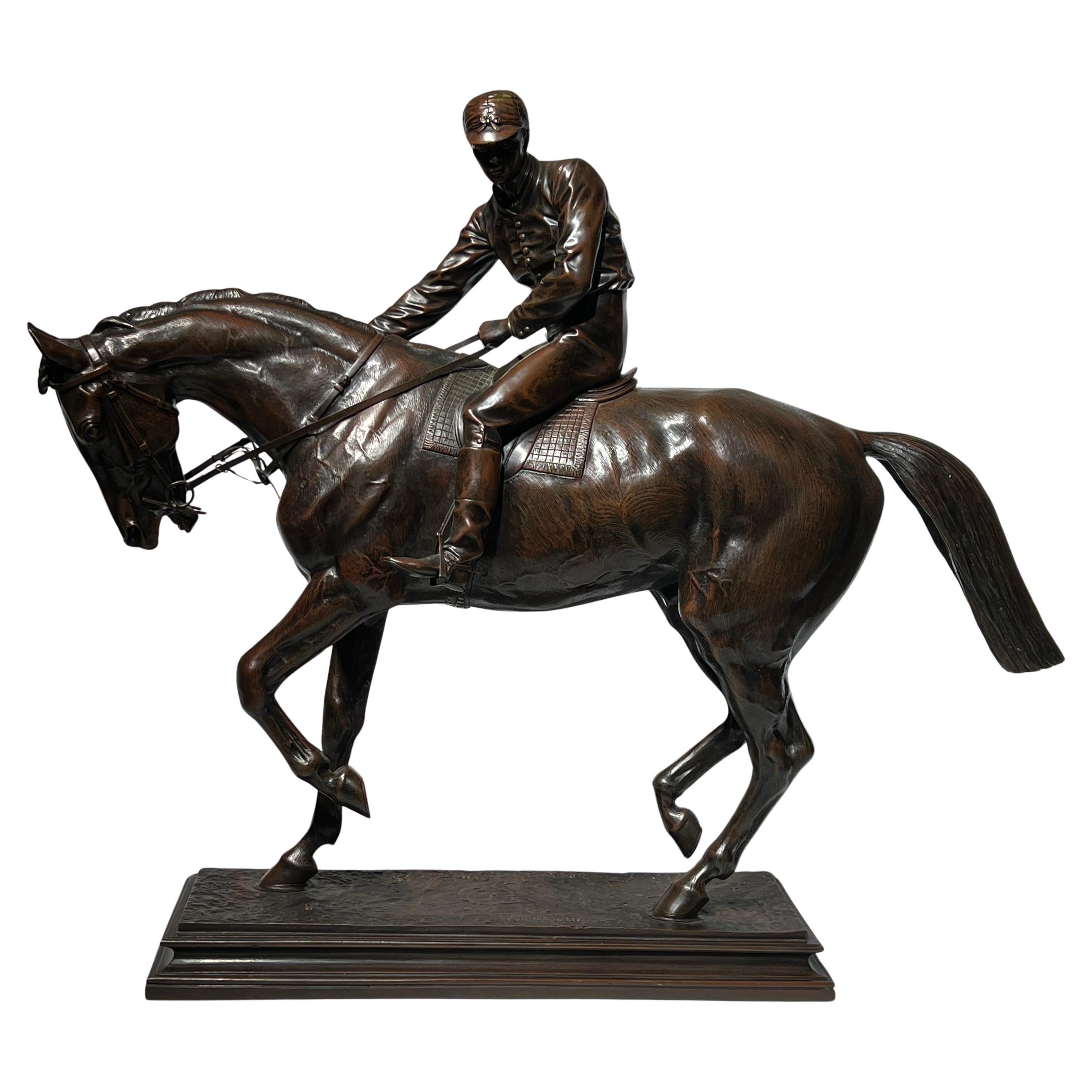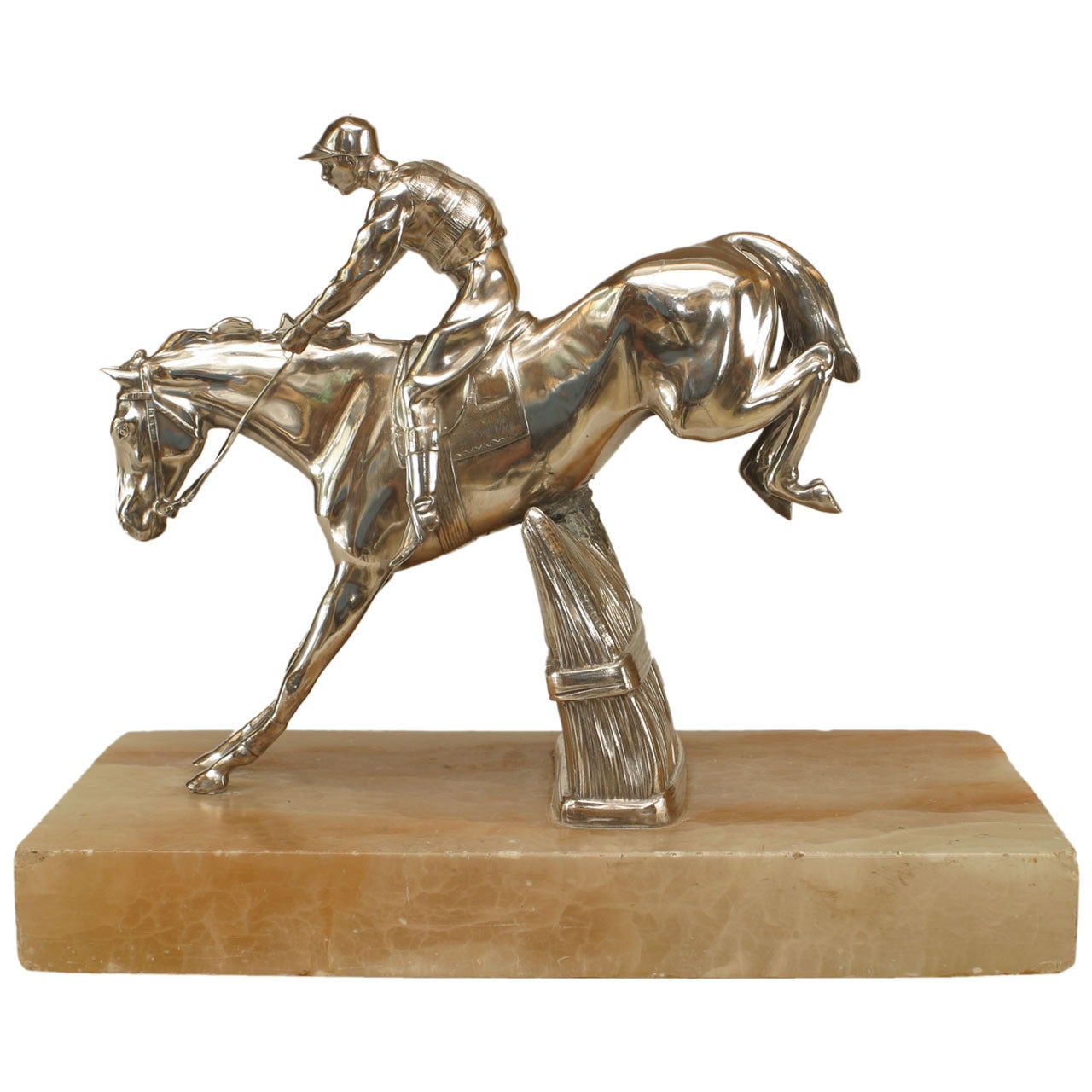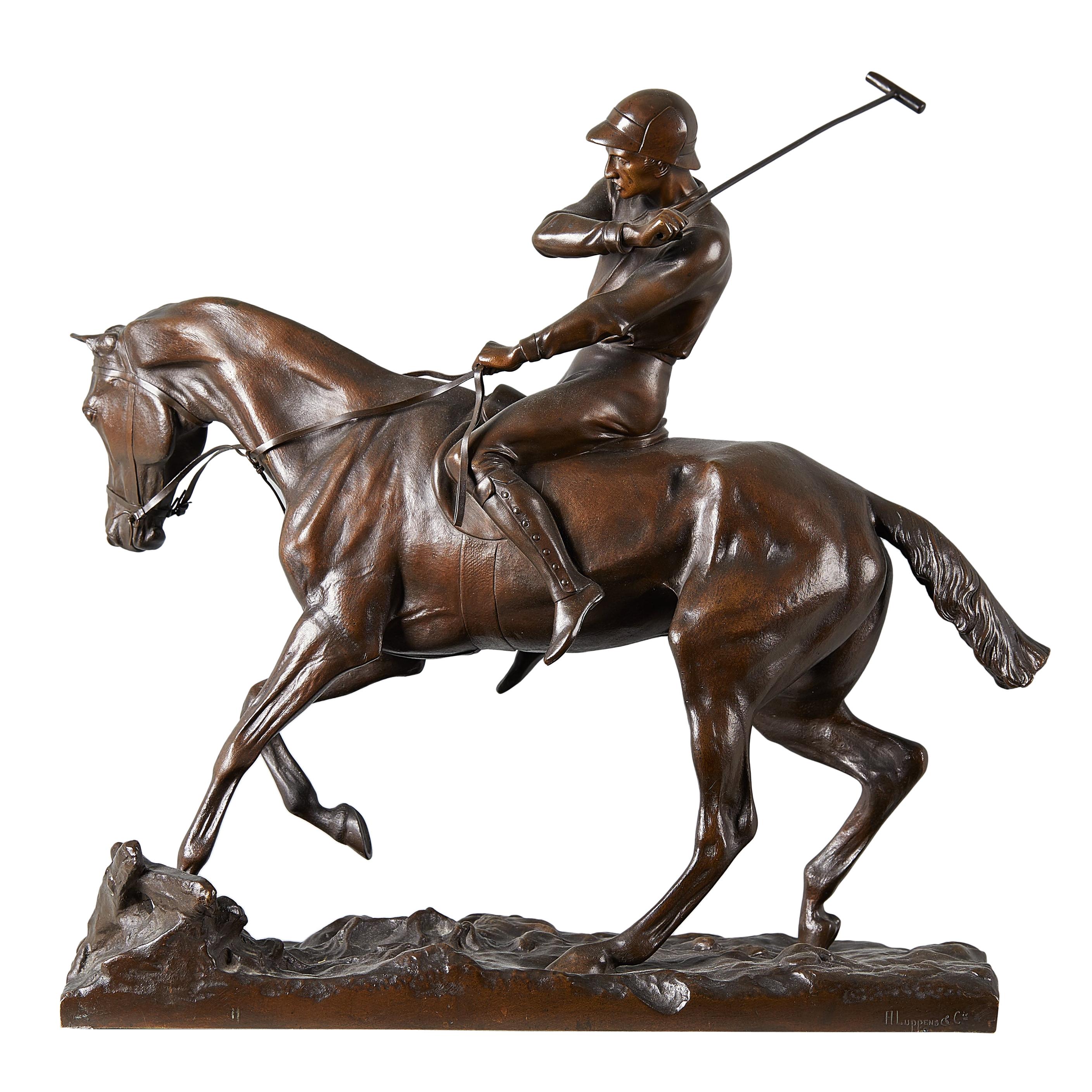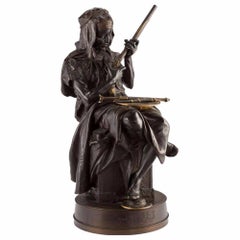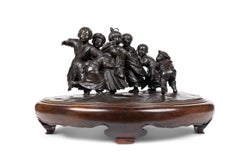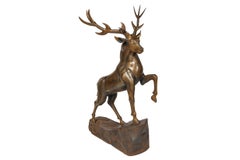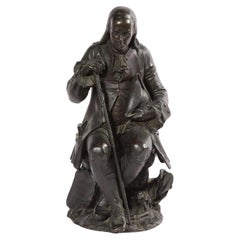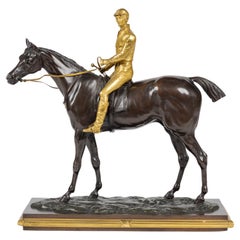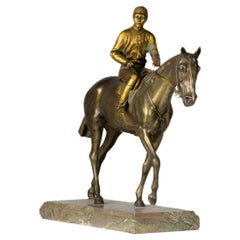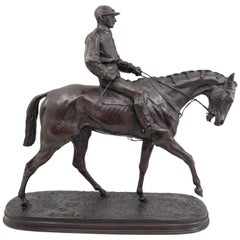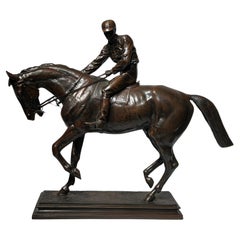Items Similar to A Rare Gilt and Patinated Bronze Jockey on A Horse, circa 1875
Video Loading
Want more images or videos?
Request additional images or videos from the seller
1 of 20
A Rare Gilt and Patinated Bronze Jockey on A Horse, circa 1875C. 1875
C. 1875
$25,000
£18,811.96
€21,748.06
CA$35,300.72
A$38,276.32
CHF 20,312.79
MX$471,421.51
NOK 251,764.23
SEK 237,607.55
DKK 162,332.87
About the Item
Isidore-Jules Bonheur (French, 1827–1901)
A Rare Gilt and Patinated Bronze Jockey on A Horse, circa 1875.
Introducing a truly exceptional and highly sought-after piece, a rare gilt and patinated bronze sculpture titled "Jockey on a Horse" by Isidore-Jules Bonheur. This remarkable artwork is a testament to Bonheur's mastery as a sculptor, capturing the dynamic energy and grace of both the jockey and his powerful equine companion.
Isidore-Jules Bonheur, a celebrated 19th-century French sculptor, was renowned for his ability to breathe life into bronze. This sculpture exemplifies his exceptional talent and unwavering attention to detail, making it a coveted treasure for art enthusiasts and collectors worldwide.
The sculpture showcases a jockey atop a spirited horse, frozen in a moment of captivating motion. The meticulous craftsmanship is evident in every aspect, from the intricate details of the jockey's attire to the sinewy muscles and flowing mane of the horse. The rich gilt and patinated bronze finish lend a sense of opulence and depth, accentuating the dynamic composition.
The interaction between the jockey and the horse is expertly captured, conveying a sense of harmonious partnership and unity. This remarkable sculpture encapsulates the thrill and spirit of equestrian pursuits, serving as a tribute to the timeless bond between man and horse.
This remarkable artwork not only captures the essence of Bonheur's artistic brilliance but also embodies the spirit of equestrian culture and the rich history of sporting art. Its enduring beauty and universal appeal ensure a desirable addition to any prestigious art collection or as a centerpiece in a sophisticated interior space.
Signed I. Bonheur
A comparable example is in the permanent collection of the Metropolitan Museum of Art
Accession Number: 64.248
Measures: 12" high x 12" wide x 5" deep
Overall excellent condition. Very crisp quality.
- Creation Year:C. 1875
- Dimensions:Height: 12 in (30.48 cm)Width: 12 in (30.48 cm)Depth: 5 in (12.7 cm)
- Medium:
- After:Isidore Jules Bonheur (1827 - 1901, French)
- Period:
- Condition:
- Gallery Location:Queens, NY
- Reference Number:1stDibs: LU1151212716602
About the Seller
5.0
Platinum Seller
Premium sellers with a 4.7+ rating and 24-hour response times
Established in 1980
1stDibs seller since 2019
15 sales on 1stDibs
- ShippingRetrieving quote...Shipping from: Queens, NY
- Return Policy
Authenticity Guarantee
In the unlikely event there’s an issue with an item’s authenticity, contact us within 1 year for a full refund. DetailsMoney-Back Guarantee
If your item is not as described, is damaged in transit, or does not arrive, contact us within 7 days for a full refund. Details24-Hour Cancellation
You have a 24-hour grace period in which to reconsider your purchase, with no questions asked.Vetted Professional Sellers
Our world-class sellers must adhere to strict standards for service and quality, maintaining the integrity of our listings.Price-Match Guarantee
If you find that a seller listed the same item for a lower price elsewhere, we’ll match it.Trusted Global Delivery
Our best-in-class carrier network provides specialized shipping options worldwide, including custom delivery.More From This Seller
View AllEmile-Edmond Peynot "Albaya' El Tunsi" The Tunisian Merchant Bronze, 1883
Located in Queens, NY
Émile-Edmond Peynot, (French, 1850 -1932)
An exceptional, exquisite and rare orientalist bronze sculpture titled Albaya' El Tunsi / The Tunisian Merchant / The Arab rifleman.
Dep...
Category
19th Century Figurative Sculptures
Materials
Bronze
A Large and Exceptional Japanese Meiji Period Tokyo School Bronze Sculpture
Located in Queens, NY
Presenting an extraordinary Large and Exceptional Japanese Meiji Period Tokyo School Bronze Sculpture depicting a delightful ensemble of six energe...
Category
19th Century Figurative Sculptures
Materials
Bronze
An Exceptional Life-Size Middle Eastern Gold-Inlaid Steel Deer Sculpture
Located in Queens, NY
An Exceptional Life-Size Middle Eastern Gold-Inlaid Steel Deer Sculpture
This extraordinary life-size Middle Eastern deer sculpture exemplifies the pinnacle of artistic craftsmanshi...
Category
20th Century Figurative Sculptures
Materials
Steel
Rare Patinated Bronze Sculpture of Benjamin Franklin, by A. Carrier-Belleuse
By Albert-Ernest Carrier-Belleuse
Located in Queens, NY
Albert-Ernest Carrier-Belleuse (France, 1824-1887)
A rare seated bronze statue of Benjamin Franklin holding his walking stick and hat, with a book in his ri...
Category
19th Century Academic Figurative Sculptures
Materials
Bronze
A Monumental Patinated Bronze Bust of Jesus Christ by Clesinger and Barbedienne
By Ferdinand Barbedienne
Located in Queens, NY
A Monumental and Truly Exceptional French Patinated Bronze Bust of Jesus Christ, Circa 1858, Signed J. Clesinger, Rome 1858 & F. Barbedienne Fondeur
This monumental and extraordinar...
Category
19th Century Figurative Sculptures
Materials
Bronze
A Monumental Gilt-Lacquered Bronze Ornamental Sculpture of Vajravidarana
Located in Queens, NY
A Monumental Gilt-Lacquered Bronze Ornamental Buddha Sculpture of Vajravidarana:
A Masterpiece of Sino-Tibetan Craftsmanship, Late 19th Century, Qing Dynasty
This monumental gilt-lacquered bronze ornamental sculpture of Vajravidarana is an extraordinary and commanding piece of art, showcasing the pinnacle of Sino-Tibetan craftsmanship from the late 19th century. The figure of Vajravidarana, a powerful purification deity in Tibetan Buddhism, is meticulously sculpted to embody both spiritual authority and artistic excellence.
Vajravidarana is primarily known for his role in removing spiritual impurities and negativities. Unlike other deities associated with wisdom or compassion, Vajravidarana’s function is centered on purification and healing. He is typically depicted holding a vajra and a bell, symbolizing the cutting away of delusions and the resonance of divine truth. In this striking sculpture, Vajravidarana is shown holding a vishva vajra (the double vajra), a unique and powerful variation of the traditional iconography, which signifies ultimate protection and the dispelling of negative karma.
Vajravidarana: The Supreme Purifier and Protector
Vajravidarana is revered in Tibetan Buddhism as the deity of spiritual purification, called upon to cleanse practitioners of defilements and negative influences. His vajra represents the indestructibility of truth, while his bell signifies the wisdom that resonates through purification rituals. In this sculpture, the presence of the vishva vajra, or double vajra, enhances his association with supreme protection, ensuring the destruction of all spiritual obstacles and afflictions.
The figure’s powerful yet composed expression conveys a sense of unwavering resolve and divine authority. His posture, along with the carefully sculpted details of his robes and ornaments, highlights his function as a guardian against impurity. The inclusion of the vishva vajra rather than the usual single vajra reinforces his role as a supreme protector, capable of dispelling all forms of negativity and restoring balance.
Symbolism of the Mantras and Aureole:
Unlike deities that embody wisdom through duality, Vajravidarana’s iconography is centered on purification and exorcism. The aureole surrounding him is inscribed with sacred purification mantras rather than depictions of a consort. These mantras emphasize his function as a remover of obstacles and impurities, reinforcing his role in Buddhist healing rituals.
The presence of the sacred inscriptions elevates the sculpture’s spiritual significance, making it a focal point for meditation and ritual purification. Practitioners often visualize Vajravidarana radiating purifying light, dissolving afflictions and negative karma. This theme is mirrored in the sculptural repetition of the purification symbols on the aureole, reinforcing the deity’s role as a divine cleanser.
Gilt-Lacquered Bronze: The Artistry of Sino-Tibetan Metalwork:
The craftsmanship of this monumental figure reflects the expertise of late 19th-century Sino-Tibetan metalwork, where traditional Tibetan themes were infused with Chinese artistic sensibilities. Cast in bronze and finished with a rich gilt lacquer, the statue has an otherworldly glow, giving it an ethereal, almost divine presence. The gilding process—applied with exceptional skill—gives the sculpture a striking luminosity that enhances the fine details of the facial features, flowing robes, jewelry, and other elements of the deity’s attire.
The technique employed to create this figure speaks to the high level of craftsmanship that flourished during the late Qing Dynasty and early modern Tibetan art. The ornate details of the robes and the fine texture of the sculpture highlight the exceptional skill of the artisans who brought this work to life. The use of gold and lacquer not only reflects the preciousness of the sculpture but also its spiritual significance as an object meant to inspire reverence and meditation.
An Ornamental Sculpture of Monumental Scale:
Unlike smaller devotional objects, this sculpture is designed as an ornamental masterpiece, intended to make a grand visual and spiritual statement. Its monumental size allows it to dominate any space, offering a commanding presence that is both physically and symbolically impressive. In Buddhist practice, large sculptures of this nature are often placed in temples or meditation halls, where their imposing size and serene presence would encourage contemplation and devotion.
The grand scale of the statue further amplifies the spiritual power it is meant to convey. As a representation of Vajravidarana, it is not only a physical object of beauty but also a conduit for meditation, purification, and enlightenment. The scale of the sculpture also emphasizes the divine stature of the deity, highlighting his importance in the Buddhist tradition as the ultimate force for spiritual cleansing and protection.
Provenance:
Acquired in China in circa 1900
1905 Private Buddhist Temple, Northeast, USA
Private Sale
Solomon Treasure...
Category
19th Century Figurative Sculptures
Materials
Bronze
You May Also Like
Isidore-Jules Bonheur, A Rare Gilt and Patinated Bronze Jockey on A Horse
By Isidore Jules Bonheur
Located in Queens, NY
Isidore-Jules Bonheur (French, 1827–1901)
A Rare Gilt and Patinated Bronze Jockey on A Horse, circa 1875.
Introducing a truly exceptional and highly s...
Category
Antique 19th Century French Sporting Art Animal Sculptures
Materials
Bronze
Gilt & Patinated Bronze Jockey on Horse, Marble Base, 19th Century
Located in Lisbon, PT
A French “Jockey à Cheval” sculpture from the Napoleon III period crafted in gilt and patinated bronze, depicting a jockey and his faithful horse in fine detail. The piece rests on a...
Category
Antique 19th Century French Napoleon III Animal Sculptures
Materials
Marble, Metal, Brass, Bronze
$2,794 Sale Price
20% Off
French Bronze Jockey on Horse by Pierre Jules Mêne
By Pierre Jules Mêne
Located in Lantau, HK
A self-taught artist, Piere-Jules Mêne (1810-1879) dedicated his entire career to making bronze statues, which were met with great success among both French and international clients...
Category
Antique 19th Century French Animal Sculptures
Materials
Bronze
Large Bronze Sculpture of a Jockey on Thoroughbred by Isidore Jules Bonheur
By Isidore Jules Bonheur
Located in New York, NY
An exceptional casting and finely patinated bronze sculpture of jockey on thoroughbred racehorse by Isidore Jules Bonheur (1827-1901), measuring 24 in tall, 26 in wide and 6 in deep....
Category
Antique Late 19th Century French Figurative Sculptures
Materials
Bronze
Victorian deskBronze Horse and Jockey
Located in Queens, NY
English Victorian silver plated bronze figure of horse and jockey jumping grass fence on white onyx rectangular shaped base
Category
Antique Early 1900s English Edwardian Sports Equipment and Memorabilia
Materials
Onyx, Bronze, Silver Plate
Joseph Cuvelier Equestrian Bronze, circa 1860
Located in Petworth, West Sussex
A Joseph Cuvelier (French 1833-1879) bronze equestrian model of a polo player, circa 1860, cast by H. Luppens & Cie, dark brown patina.
Category
Antique Mid-19th Century French Figurative Sculptures
Materials
Bronze
$5,143 Sale Price
20% Off
More Ways To Browse
Antique Jockey
19th Century Bronze Horse Sculpture
Horse Jockey
Jockeys And Horse
Gilt Horse
Bonheur Bronze
Jockey Sculpture
Jockey On Horse
Bronze Jockey
Bonheur Bronze Sculpture
Horse Jockey Sculpture
Horse And Jockey Bronze
Jockey On Bronze Horse
Jockey On Horse Sculpture
Bonheur Horse
Susan Kemenyffy
Taller Alfonso Castillo Orta
Tete De Chevre De Profil
